B0041VYHGW EBOK (179 page)
Authors: David Bordwell,Kristin Thompson

But already there is a sense that such unity is in danger. Esther sings, “Someday soon we all will be together, if the Fates allow / Until then we’ll have to muddle through somehow.” We know already that Esther has achieved her romantic goal and become engaged to John Truitt. If the Smiths do move to New York, she will have to decide between him and her family. By this point, the plot has reached an impasse; whichever way she decides, the old way of life will be destroyed. The narrative needs a resolution, and Tootie’s hysterical crying in reaction to the song leads Mr. Smith to reconsider his decision.
Tootie’s destruction of the snow people after Esther’s song is a striking image of the threat to family unity posed by the move to New York. As the winter season section opened, the children were building the snow people (and a dog) in the yard. In effect, they had created a parallel to their own family
(
11.97
).
At first these snow people were part of the comic scene in which Esther and Katie persuade Lon and Rose to go to the Christmas dance together. But when Tootie becomes hysterical at the prospect of leaving St. Louis, she runs down in her nightgown to smash the snow people. The scene is almost shocking, since Tootie seems to be killing the doubles of her own family
(
11.98
).
This moment has to be emotional because it must motivate the father’s change of mind. He realizes that his desire to move to New York threatens the family’s harmony. This realization leads to his decision to stay in St. Louis.
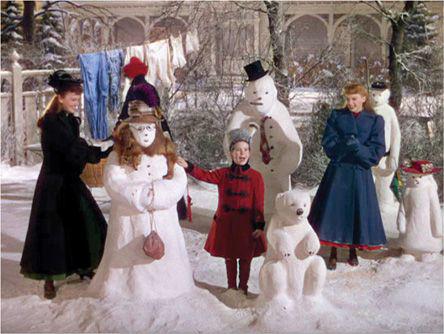
11.97 Snow people of various sexes and sizes parallel the family.

11.98 Tootie’s attack on the snow people.
Two other elements of the mise-en-scene create motifs that stress the family’s comfortable life. The Smiths live surrounded by food. In the initial scene, the women are making ketchup, which is shortly served at the family dinner. After the scene in which Rose’s boyfriend fails to propose to her by phone, the tensions are reconciled, and the maid serves large slices of corned beef.
In the Halloween scene, the connection between plentiful food and family unity becomes even more explicit. At first, the children gather around to eat cake and ice cream, but the father arrives home and makes his announcement about moving to New York. The family members depart without touching their food. Only when they hear the mother and father singing at the piano do they gradually drift back to eat
(
11.99
).
The words of the song—“Time may pass, but we’ll be together”—accompany their actions. The use of food as a motif associates the family’s life in the house with plenty and with the individual’s place as part of a group. At the fair in the last sequence, they decide to visit a restaurant together. Thus the food motif returns at the moment of their reaffirmation of their life together in St. Louis.

11.99 A framing in depth stresses the family as a group, with a plate of cake prominent on the piano in the foreground.
Another motif of family unity involves light. The house is ablaze much of the time. As the family sits together at dinner, the low evening sun sends bright yellow rays through the white curtains. Later, one of the loveliest scenes involves Esther’s request that John accompany her through the downstairs to help her turn out the lights. This action is primarily accomplished in one long take, with a crane shot following the characters from room to room
(
11.100
).
As the rooms darken and the couple moves out to the hall, the camera cranes down to a height level with their faces. The shot contains a remarkable shift of tone. It begins with Esther’s comically contrived excuse (“I’m afraid of mice”) to keep John with her and develops gradually toward a genuinely romantic mood.
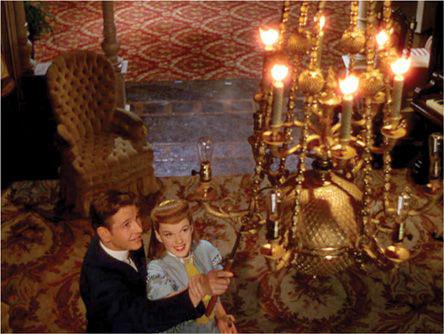
11.100 At each pause in the long-take camera movement, the chandelier is framed in the upper portion of the screen.
The Halloween sequence takes place entirely at night and makes light a central motif. The camera initially moves in toward the house’s glowing yellow windows. Tense, slightly eerie music makes the house seem an island of safety in the darkness. As Tootie and Agnes go out to join the other children in playing tricks, they are silhouetted against the flames of the bonfire the group has gathered around. At first the fire seems threatening, contradicting the earlier associations of light with safety and unity, but this scene actually harmonizes with the previous uses of light. Tootie is excluded from the group activities because she is “too little.” After she proves herself worthy, she is allowed to help feed the flames along with the others. Note particularly the long track-back as Tootie leaves the fire to play her trick; the fire remains in the background of the shot, appearing as a haven she has left behind
(
11.101
).
Indeed, the first sequence of the Halloween section of the film becomes a sort of miniature working out of the entire narrative structure. Tootie’s position as a part of the group is abandoned as she moves away from the fire, then triumphantly affirmed as she returns to it.
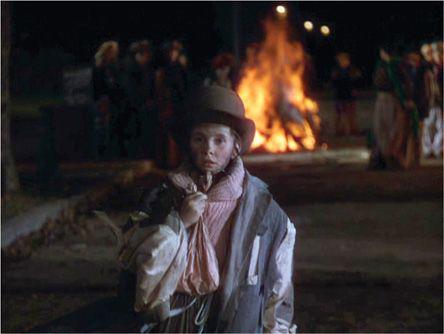
11.101 A terrified Tootie moves into the darkness to play her trick.
Similarly, light plays an important part in the resolution of the threat to the family’s unity. Late on Christmas Eve, Esther finds Tootie awake. They look out the window at the snow people standing in the yard below. A strip of yellow light falls across the snow, suggesting the warmth and safety of the house they plan to leave (
11.98
). Tootie’s hysterical crying, however, leads Mr. Smith to reconsider his decision. As he sits thinking, he holds the match, with which he was about to light his cigar, unnoticed in his hand until it burns his fingers. Combined with the slow playing of the “Meet Me in St. Louis” theme, the flame serves to emphasize his distraction and his gradual change of mind.
As he calls his family down to announce his decision not to move, he turns up all the lights. The dim, bleak halls full of packing boxes become again the scene of busy activity as the family gathers. The lamps’ glass shades are red and green, identifying the house with the appropriate Christmas colors and recalling Esther’s and Rose’s party dresses. The announcement of the decision leads directly to the opening of the presents, as if to emphasize that staying in St. Louis will not create any financial hardship for the family.
As night falls in the final fair sequence, the many lights of the buildings come on, dazzlingly reflected in lakes and canals
(
11.102
).
Here the film ends, with the family gazing in awe at the view. Once more light signifies safety and family enjoyment. These lights also bring the other motifs of the film together. The father had originally wanted to move to New York as a provision for his family’s future. In deciding to stay in St. Louis, he had told them: “New York hasn’t got a copyright on opportunity. Why, St. Louis is headed for a boom that’ll make your head swim. This is a great town.” The fair confirms this. St. Louis allows the family to retain its unity, comfort, and safety and yet have all the benefits of progress. The film ends with this dialogue:
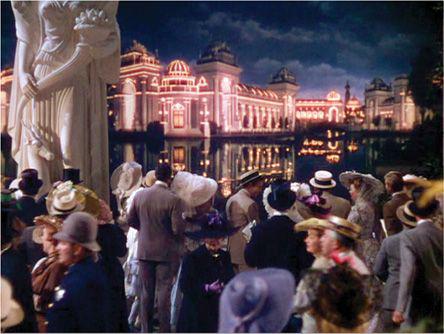
11.102 The motif of light culminates in the revelation of the fairgrounds.
MOTHER: There’s never been anything like it in the whole world.
ROSE: We don’t have to come here in a train or stay in a hotel. It’s right in our own hometown.
TOOTIE: Grandpa, they’ll never tear it down, will they?
GRANDPA: Well, they’d better not.
ESTHER: I can’t believe it. Right here where we live. Right here in St. Louis
(
11.103
).
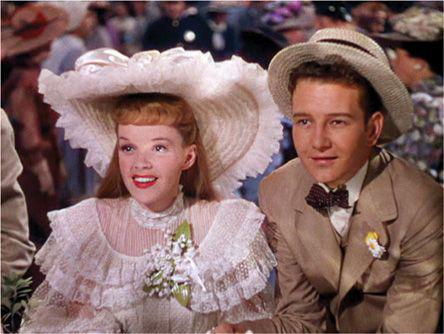
11.103 The film’s final shot, with Esther’s dazzled reaction to the fair.